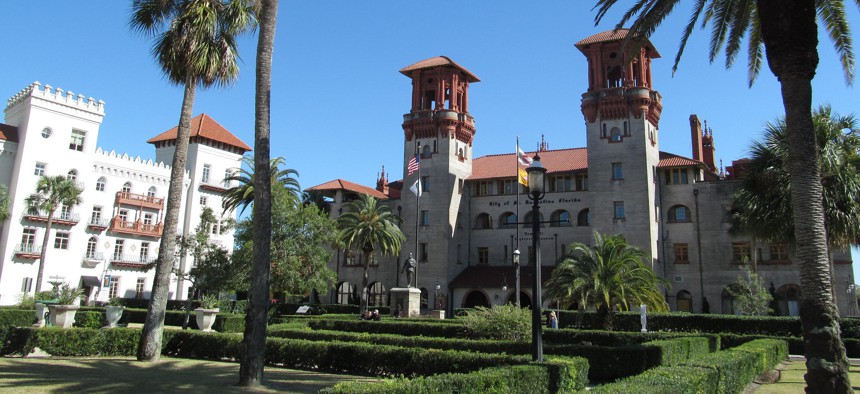One Florida Mayor’s ‘Huge Wakeup Call’ About Sea Level Rise

City Hall in St. Augustine, Florida Doug Kerr / Flickr via CC BY-SA 2.0
It involved sea urchins in an unexpected place.
Editor’s Note: This is the first in a series of articles based on interviews with city officials at the 2017 Resilient Cities Summit. The National League of Cities, the Urban Land Institute, and the U.S. Green Building Council held the event in Stowe, Vermont between July 17 and 19.
Mayor Nancy Shaver, of St. Augustine, Florida recalls learning about the sea urchins that were turning up in her city’s stormwater drains.
It was around the time Shaver took office, after being elected to her first two-year term in 2014. The mayor was walking in a city neighborhood when a resident told her the sea creatures were appearing in the drains every so often.
“That was a huge wakeup call,” Shaver said.
“That means we have saltwater, enough saltwater that’s flowing back into our stormwater system, to keep a sea urchin happy,” she added. That’s problematic because if too much sea water infiltrates the system it raises the risk of drainage backups and flooding.
“Unless you wanted a cash crop of sea urchins,” said Shaver, “you knew you had an issue to deal with.”
Kathryn Frank is a professor at the University of Florida’s College of Design, Construction and Planning, and has led research on coastal adaptation and sea level rise.
Frank emphasized that she had not studied St. Augustine’s stormwater system. But she explained by phone Thursday that saltwater can back up into stormwater systems in the places where the systems empty into the ocean. “Because a lot of discharge is to the ocean,” she said.
And, in low-lying areas, it can take just a little bit of sea level rise to start causing backups.
“It may not take much to cause it to start,” Frank said, “to be noticeable.”
That said, a variety of factors can put extra strain on stormwater systems, and put them at risk of overflowing, including heavy rainfall, extremely high tides and the level of the underground water table.
St. Augustine has about 14,000 residents and is located on the Atlantic coast in northeast Florida, about 35 miles southeast of Jacksonville.
The city began an effort in 2015, after Shaver heard about the urchins in the drains, to get a better grasp on the threat it faces from rising ocean waters. An initial step the city took was to have researchers at the University of Florida conduct a sea level rise study.
Estimates included in the study suggest that, relative to land, sea levels could go up in the region where St. Augustine is located by roughly 3 inches to 1 foot by 2030. By 2050, those low and high projections increase to around 4 inches and 2 feet.

The study also says about 1,300 acres, or one quarter of the city’s land, would be “inundated” with 1 foot of relative sea level rise, which is projected as early as 2030, or as late as 2070.
Since the initial study, St. Augustine sought out a report to identify specific vulnerabilities in the city under different sea level rise scenarios, and how the resulting risks might be addressed.
Shaver had just received a draft copy of that latest report, but hadn’t given it a close read yet, when she spoke with Route Fifty at an event in Vermont earlier this week.
But a major piece of city infrastructure that is believed to be in jeopardy given sea level rise projections is St. Augustine’s sewer treatment plant. “The outfall, at two feet of sea level rise, is toast,” said Shaver, referring to the part of the system where treated water empties out.
Building a new, conventional wastewater facility elsewhere to serve St. Augustine would cost upwards of $100 million, according to the mayor.
That would be a heavy financial lift for the city. “We have a $50 million annual budget,” Shaver noted. How St. Augustine will address the looming risks to the facility, she said, is “an open question.”
The answer promises to have some important implications.
“The job of a city is to deliver basic services. People want their toilets to flush,” Shaver said. “We need to figure out how to continue to make that happen.”
Risks from sea level rise are not unique to St. Augustine. Cities that are comparable in size are located all along Florida’s coast. The range of troubles rising water could create for these communities goes beyond sewage and stormwater facilities getting inundated.
Shaver pointed out, for instance, that Florida sits atop porous limestone, which raises the potential for saltwater from the ocean to seep into underground aquifers used to supply drinking water. St. Augustine has what’s known as a reverse osmosis drinking water plant, that helps alleviate the problem of saltwater in drinking water.
The city has also installed equipment to prevent seawater from flowing backwards into the stormwater drainage system. But Shaver described this as a “duct-tape solution.”
She pointed out that there are areas within St. Augustine that developers built on fill material decades ago and she said these places would be especially vulnerable to rising ocean waters.

The mayor expressed an interest in finding ways for Florida’s coastal cities to work together to share knowledge and perhaps come up with policies focused on issues like protecting groundwater. But she said that support for climate-related initiatives is limited at the state level.
“I tend not to get stuck on how many feet and when,” Shaver said, referring to sea level rise projections for future years. “What’s important is we need to plan for it, it’s coming.”
NEXT in this Route Fifty series:
Bill Lucia is a Senior Reporter for Government Executive’s Route Fifty and is based in Washington, D.C.
(Top photo by Doug Kerr / Flickr via CC BY-SA 2.0)
NEXT STORY: The Route Fifty Roadshow Goes To Columbus






